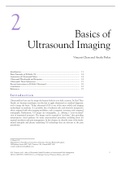2 Basics of
Ultrasound Imaging
Vincent Chan and Anahi Perlas
Introduction.................................................................................................................... 13
Basic Principles of B-Mode US...................................................................................... 14
Generation of Ultrasound Pulses.................................................................................... 14
Ultrasound Wavelength and Frequency......................................................................... 14
Ultrasound–Tissue Interaction....................................................................................... 15
Recent Innovations in B-Mode Ultrasound................................................................... 18
Conclusion...................................................................................................................... 19
References....................................................................................................................... 19
Introduction
Ultrasound has been used to image the human body for over half a century. Dr. Karl Theo
Dussik, an Austrian neurologist, was the first to apply ultrasound as a medical diagnostic
tool to image the brain.1 Today, ultrasound (US) is one of the most widely used imaging
technologies in medicine. It is portable, free of radiation risk, and relatively inexpensive
when compared with other imaging modalities, such as magnetic resonance and computed
tomography. Furthermore, US images are tomographic, i.e., offering a “cross-sectional”
view of anatomical structures. The images can be acquired in “real time,” thus providing
instantaneous visual guidance for many interventional procedures including those for
regional anesthesia and pain management. In this chapter, we describe some of the funda-
mental principles and physics underlying US technology that are relevant to the pain
practitioner.
V. Chan ()
Department of Anesthesia, University of Toronto, Toronto Western Hospital,
399 Bathurst Street MP 2-405, Toronto, ON, Canada M5T 2S8
e-mail: mail2vincechan@aol.com
S.N. Narouze (ed.), Atlas of Ultrasound-Guided Procedures in Interventional Pain Management, 13
DOI 10.1007/978-1-4419-1681-5_2, © Springer Science+Business Media, LLC 2011
, Atlas of Ultrasound-Guided Procedures in Interventional Pain Management
Basic Principles of B-Mode US
Modern medical US is performed primarily using a pulse-echo approach with a
brightness-mode (B-mode) display. The basic principles of B-mode imaging are much the
same today as they were several decades ago. This involves transmitting small pulses of
ultrasound echo from a transducer into the body. As the ultrasound waves penetrate body
tissues of different acoustic impedances along the path of transmission, some are reflected
back to the transducer (echo signals) and some continue to penetrate deeper. The echo
signals returned from many sequential coplanar pulses are processed and combined to
generate an image. Thus, an ultrasound transducer works both as a speaker (generating
sound waves) and a microphone (receiving sound waves). The ultrasound pulse is in fact
quite short, but since it traverses in a straight path, it is often referred to as an ultrasound
beam. The direction of ultrasound propagation along the beam line is called the axial
direction, and the direction in the image plane perpendicular to axial is called the lateral
direction.2 Usually only a small fraction of the ultrasound pulse returns as a reflected echo
after reaching a body tissue interface, while the remainder of the pulse continues along the
beam line to greater tissue depths.
Generation of Ultrasound Pulses
Ultrasound transducers (or probes) contain multiple piezoelectric crystals which are inter-
connected electronically and vibrate in response to an applied electric current. This phe-
nomenon called the piezoelectric effect was originally described by the Curie brothers in
1880 when they subjected a cut piece of quartz to mechanical stress generating an electric
charge on the surface.3 Later, they also demonstrated the reverse piezoelectric effect, i.e.,
electricity application to the quartz resulting in quartz vibration.4 These vibrating mechan-
ical sound waves create alternating areas of compression and rarefaction when propagating
through body tissues. Sound waves can be described in terms of their frequency (measured
in cycles per second or hertz), wavelength (measured in millimeter), and amplitude (mea-
sured in decibel).
Ultrasound Wavelength and Frequency
The wavelength and frequency of US are inversely related, i.e., ultrasound of high
frequency has a short wavelength and vice versa. US waves have frequencies that exceed
the upper limit for audible human hearing, i.e., greater than 20 kHz.3 Medical ultrasound
devices use sound waves in the range of 1–20 MHz. Proper selection of transducer fre-
quency is an important concept for providing optimal image resolution in diagnostic and
procedural US. High-frequency ultrasound waves (short wavelength) generate images of
high axial resolution. Increasing the number of waves of compression and rarefaction for a
given distance can more accurately discriminate between two separate structures along the
axial plane of wave propagation. However, high-frequency waves are more attenuated
than lower frequency waves for a given distance; thus, they are suitable for imaging mainly
superficial structures.5 Conversely, low-frequency waves (long wavelength) offer images of
lower resolution but can penetrate to deeper structures due to a lower degree of attenua-
tion (Figure 2.1). For this reason, it is best to use high-frequency transducers (up to
10–15 MHz range) to image superficial structures (such as for stellate ganglion blocks) and
low-frequency transducers (typically 2–5 MHz) for imaging the lumbar neuraxial struc-
tures that are deep in most adults (Figure 2.2).
Ultrasound waves are generated in pulses (intermittent trains of pressure) that com-
monly consist of two or three sound cycles of the same frequency (Figure 2.3). The pulse
14




